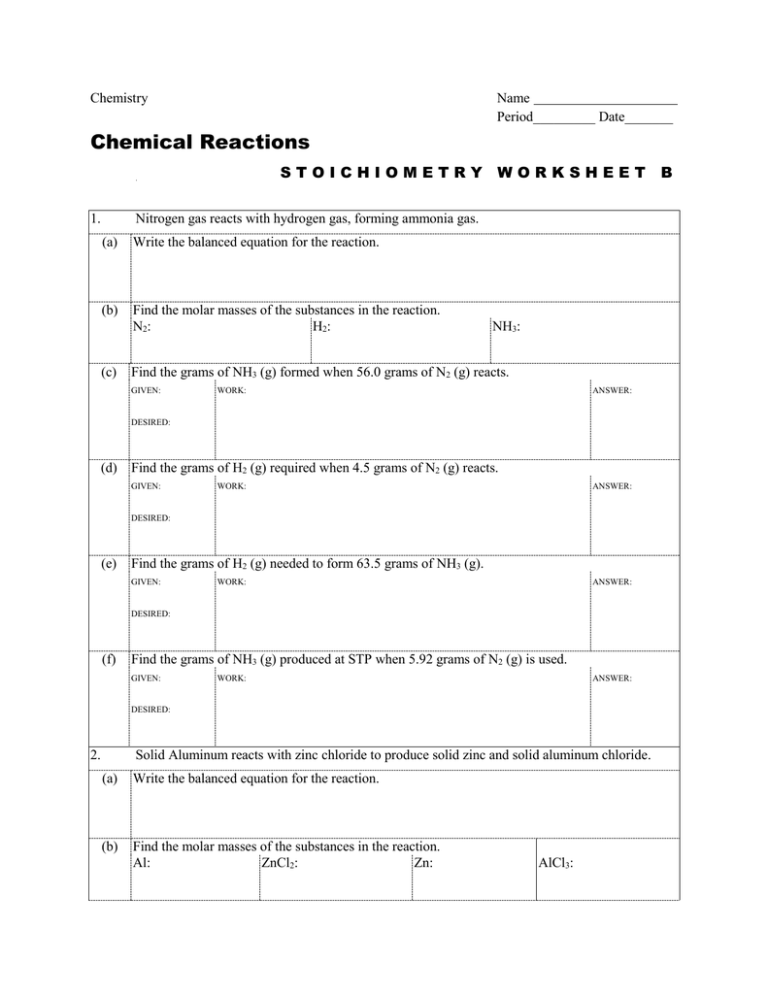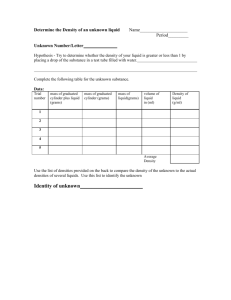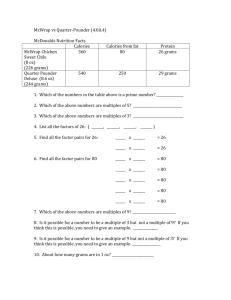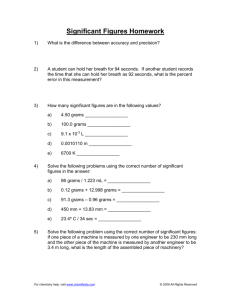Stoichiometry Worksheet B
advertisement

Chemistry Name Period_________ Date_______ Chemical Reactions STOICHIOMETRY WORKSHEET 1. Nitrogen gas reacts with hydrogen gas, forming ammonia gas. (a) Write the balanced equation for the reaction. (b) Find the molar masses of the substances in the reaction. N2: H2: (c) NH3: Find the grams of NH3 (g) formed when 56.0 grams of N2 (g) reacts. GIVEN: WORK: ANSWER: DESIRED: (d) Find the grams of H2 (g) required when 4.5 grams of N2 (g) reacts. GIVEN: WORK: ANSWER: DESIRED: (e) Find the grams of H2 (g) needed to form 63.5 grams of NH3 (g). GIVEN: WORK: ANSWER: DESIRED: (f) Find the grams of NH3 (g) produced at STP when 5.92 grams of N2 (g) is used. GIVEN: WORK: ANSWER: DESIRED: 2. Solid Aluminum reacts with zinc chloride to produce solid zinc and solid aluminum chloride. (a) Write the balanced equation for the reaction. (b) Find the molar masses of the substances in the reaction. Al: ZnCl2: Zn: AlCl3: B (c) Find the mass of ZnCl2 (s) produced when 45.0 grams of Al (s) react. GIVEN: WORK: ANSWER: DESIRED: (d) Find the grams of AlCl3 (g) produced when 22.6 grams of ZnCl2 are used up. GIVEN: WORK: ANSWER: DESIRED: 3. Potassium iodide reacts with bromide gas to produce potassium bromide and iodine. (a) Write the balanced equation for the reaction. (b) Find the mass of KI (s) required to produce 42.0 grams of I2 (g). GIVEN: WORK: ANSWER: DESIRED: (c) Calculate the grams of bromine (g) required to produce 125.7 grams of I2 (g). GIVEN: WORK: ANSWER: DESIRED: (d) Calculate the grams of potassium bromide produced from 30.2 grams of KI. GIVEN: WORK: ANSWER: DESIRED: 4. A solution of Iron(II) acetate is combined with a solution of hydrochloric acid forming Iron (II) chloride and acetic acid. (a) Write the balanced equation for the reaction. (b) Find the molar masses of the substances in the reaction. Fe(C2H3O2)2: HCl: FeCl2 HC2H3O2: (c) Find the mass of Iron (II) acetate required to react to form 65.5 g of Iron (II) chloride. GIVEN: WORK: ANSWER: DESIRED: (d) Calculate the grams of acetic acid produced when 77.5 g of Iron (II) chloride is formed. GIVEN: WORK: ANSWER: DESIRED: 5. Zinc chloride reacts with ammonium phosphate to form zinc phosphate and ammonium chloride. (a) Write the balanced equation for the reaction. (b) Find the molar masses of the substances in the reaction. ZnCl2: (NH4)3PO4: Zn3PO4: (c) NH4Cl How many grams of zinc phosphate will be produced from 5 grams of ammonium phosphate? GIVEN: WORK: ANSWER: DESIRED: (d) How many grams of ammonium phosphate are needed to produce 24.5 grams of zinc phosphate? GIVEN: WORK: ANSWER: DESIRED: (e) How many grams of ammonium chloride are there if 6.8 grams of zinc phosphate are produced? GIVEN: WORK: ANSWER: DESIRED: (f) How many grams of zinc chloride are needed to react with 8.9 grams of ammonium phosphate? GIVEN: WORK: DESIRED: 6. (a) Sodium reacts with oxygen gas to produce sodium oxide Write the balanced equation for the reaction. ANSWER: (b) (c) Find the molar masses of the substances in the reaction. Na: O2: Na2O: How many grams of sodium are needed to react with 34.5 grams of oxygen? GIVEN: WORK: ANSWER: DESIRED: (d) How many grams of sodium oxide are produced from 45 grams of oxygen? GIVEN: WORK: ANSWER: DESIRED: 7. Cadmium nitrate reacts with copper (II) sulfate to produce cadmium sulfate and copper (II) nitrate. (a) Write the balanced equation for the reaction. (b) How many grams of cadmium nitrate are needed to react with 75.4 grams of copper (II) sulfate? GIVEN: WORK: ANSWER: DESIRED: (c) How many grams of cadmium sulfate are produced from 69.5 grams of cadmium nitrate? GIVEN: WORK: ANSWER: DESIRED: (d) How many grams of copper (II) nitrate are produced from 35.6 grams of copper (II) nitrate? GIVEN: DESIRED: WORK: ANSWER: 8. C6H6 + Cl2 C6H5Cl + HCl (a) Write the balanced equation for the reaction. (b) What is the theoretical yield of C6H5Cl if 45.6 grams of C6H6 reacts? GIVEN: WORK: ANSWER: DESIRED: (c) If the actual yield is 63.7 grams of C6H5Cl, calculate the percent yield? GIVEN: WORK: ANSWER: DESIRED: (d) What is the theoretical yield of C6H5Cl if 35.4 grams of chlorine gas reacts? GIVEN: WORK: ANSWER: DESIRED: (e) If the actual yield of C6H5Cl is 53.5 grams, what is the percent yield? GIVEN: WORK: ANSWER: DESIRED: 9. Carbon disulfide and oxygen gas react to form carbon dioxide and sulfur dioxide. (a) Write the balanced equation for the reaction. (b) What is the theoretical yield of sulfur dioxide if 25.0 grams of carbon disulfide reacts? GIVEN: WORK: ANSWER: DESIRED: (c) If the actual yield of sulfur dioxide is 40.5 grams, what is the percent yield? GIVEN: DESIRED: WORK: ANSWER: 10. Arsenic (III) oxide reacts with carbon to produce carbon dioxide and arsenic. (a) Write the balanced equation for the reaction. (b) What is the theoretical yield of arsenic if 8.87 grams of arsenic (III) oxide reacts? GIVEN: WORK: ANSWER: DESIRED: (c) If the actual yield of arsenic is 5.33 grams, what is the percent yield? GIVEN: WORK: ANSWER: DESIRED: (d) If the actual yield of arsenic is 4.85 grams, what is the percent yield? GIVEN: WORK: ANSWER: DESIRED: 11. Mercury (II) oxide reacts with chlorine gas to produce mercury (II) chloride and dichlorine monoxide (a) Write the balanced equation for the reaction. (b) What is the theoretical yield of mercury (II) chloride if 55.7 grams of mercury (II) oxide reacts? GIVEN: WORK: ANSWER: DESIRED: (c) If the actual yield of mercury (II) chloride is 65.5 grams, what is the percent yield? GIVEN: WORK: ANSWER: DESIRED: (d) If the actual yield of mercury (II) chloride is 60.5 grams, what is the percent yield? GIVEN: DESIRED: WORK: ANSWER:





